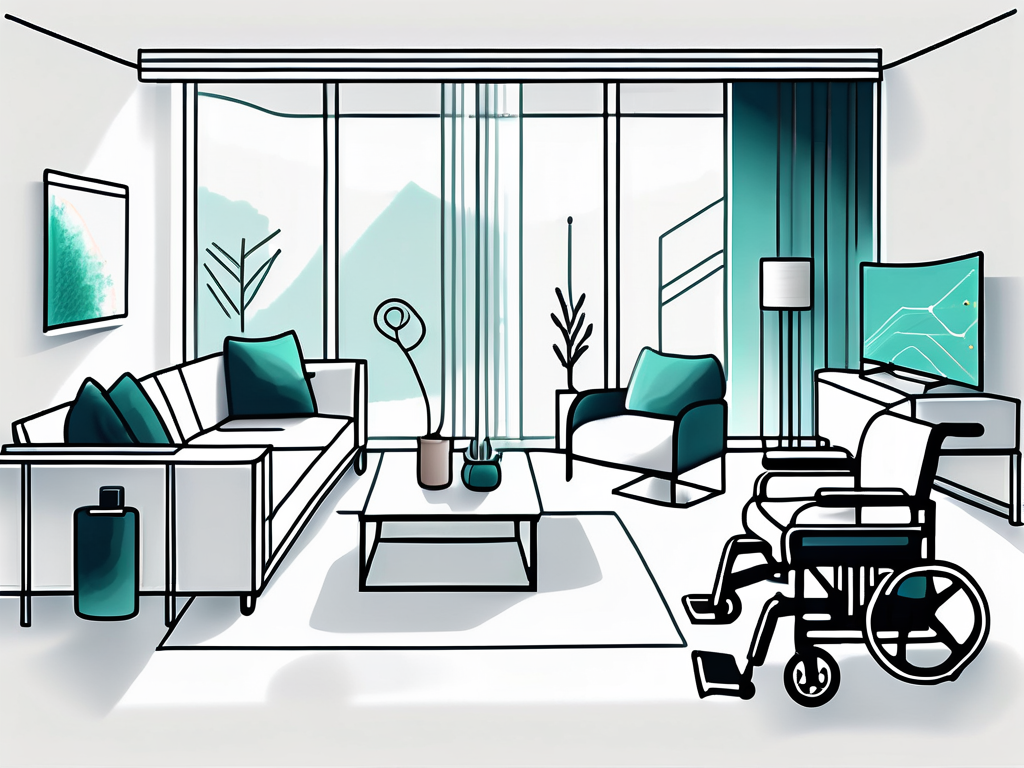The senior living industry is undergoing a significant transformation, driven by the rapid advancements in technology. As the population ages and the demand for quality senior care continues to rise, technology is playing an increasingly vital role in meeting the complex needs of seniors and their caregivers.
Understanding the Current Landscape of Senior Living Technology
In order to fully comprehend the future of senior living technology, it is essential to first understand the current landscape. Technology has already become deeply integrated into many aspects of senior living, enhancing the overall quality of life for seniors and enabling caregivers to provide better care.

Senior living technology is a rapidly evolving field that is reshaping the way seniors experience their golden years. From smart devices that remind seniors to take their medications to virtual reality systems that transport them to far-off places, the possibilities are endless. These technological advancements not only improve the safety and well-being of seniors but also foster a sense of connection and engagement.
The Role of Technology in Senior Living Today
Technology has become a lifeline for seniors, empowering them to maintain their independence and stay connected to their loved ones. From wearable devices that monitor health parameters and detect falls to smart home systems that enable easier access to essential services, technology is revolutionizing the way seniors live.
Furthermore, technology is not just a convenience but a necessity in senior living communities. It serves as a proactive tool in preventing emergencies and addressing health concerns before they escalate. By leveraging the power of artificial intelligence and machine learning, senior living technology can anticipate the needs of residents and provide personalized care solutions.
Key Technologies in Use
Several key technologies are currently being utilized in senior living communities. Electronic medication management systems ensure accurate medication administration, while telehealth platforms enable remote consultations with healthcare professionals. Sensor-based monitoring systems provide real-time data on residents’ activities, helping caregivers detect any changes in health or behavior.
Moreover, robotic companions are gaining popularity in senior living facilities, offering companionship and assistance with daily tasks. These robots are equipped with advanced capabilities such as voice recognition and emotional intelligence, making them valuable members of the caregiving team. As technology continues to advance, the possibilities for enhancing the lives of seniors in residential settings are limitless.
The Evolution of Technology in Senior Living
The evolution of technology in senior living has been remarkable, with advancements shaping the industry in various ways.

As technology continues to progress, the landscape of senior living is undergoing a transformative shift. Innovations are not only enhancing the quality of life for older adults but also revolutionizing the way care is delivered in senior communities. From wearable health monitoring devices to virtual reality therapy programs, the possibilities for improving the well-being of seniors through technology are endless.
From Basic to Advanced: A Brief History
Initially, technology in senior living focused on basic necessities such as emergency response systems and electronic medical records. Over time, the capabilities expanded, integrating smart devices, voice assistants, and personalized communication platforms. This evolution has led to the creation of smart homes and communities designed specifically to meet the needs of seniors.
Moreover, the integration of artificial intelligence and machine learning algorithms is paving the way for predictive healthcare analytics in senior living. By analyzing data from various sources, these technologies can anticipate potential health issues and provide proactive care, ultimately improving outcomes and reducing hospitalizations among older adults.
The Impact of Technological Advancements on Senior Living
Technological advancements have had a profound impact on the quality of life for seniors. They promote independence, enable better communication with caregivers and loved ones, and provide access to comprehensive healthcare resources. These advancements have also helped to address the increasing demand for senior care by improving efficiency and reducing reliance on traditional caregiving models.
Furthermore, the implementation of robotics and automation in senior living facilities is streamlining tasks such as medication management, housekeeping, and meal preparation. This not only frees up staff to focus on more personalized care but also ensures that residents receive timely and accurate assistance, enhancing their overall living experience.
Predicting the Future of Senior Living Technology
Looking ahead, the future of senior living technology holds great promise, with new innovations set to revolutionize the industry even further. As technology continues to advance at a rapid pace, the landscape of senior care is poised to undergo significant transformations, enhancing the quality of life for older adults and improving the efficiency of care delivery.

One of the key areas driving this transformation is the integration of cutting-edge technologies that cater specifically to the needs of seniors, ensuring a more personalized and holistic approach to their well-being. From smart home devices that monitor vital signs and detect emergencies to wearable technology that tracks activity levels and medication adherence, the future of senior living is increasingly becoming interconnected and data-driven.
Emerging Technologies and Their Potential
Emerging technologies such as virtual reality, artificial intelligence, and Internet of Things (IoT) devices are expected to play a crucial role in shaping the future of senior living. Virtual reality can transport seniors to different environments, promoting mental stimulation and preventing loneliness. AI-powered systems can assist with monitoring health conditions and identifying potential risks, while IoT devices can seamlessly connect various aspects of daily living.
Furthermore, the rise of telemedicine and remote monitoring solutions is revolutionizing how healthcare is delivered to seniors, enabling timely interventions and reducing the need for frequent hospital visits. These technologies not only empower older adults to take control of their health but also provide healthcare providers with valuable insights to deliver more proactive and personalized care.
The Role of AI and Robotics in Future Senior Living
AI and robotics are expected to revolutionize the way senior care is delivered. Smart robots can assist with household chores, provide companionship, and even offer physical support to seniors. AI algorithms can analyze vast amounts of data to personalize care plans and predict potential health issues, enabling proactive interventions and reducing healthcare costs.
Moreover, the integration of voice-activated assistants and smart sensors in senior living environments is creating a more intuitive and responsive ecosystem that caters to the unique needs of older adults. These technologies not only enhance safety and security but also promote independence and social engagement, fostering a sense of community and well-being among seniors.
Challenges and Opportunities in Implementing New Technologies
While the potential benefits of senior living technology are enormous, there are challenges that must be addressed for successful implementation.
One key challenge in implementing new technologies in senior living communities is the need to ensure that the solutions are tailored to meet the unique needs and preferences of older adults. This requires a deep understanding of the diverse capabilities and limitations that come with aging, as well as the importance of user-friendly interfaces and intuitive design.
Understanding the Barriers to Technology Adoption
Resistance to change, lack of digital literacy among seniors, and concerns about privacy and security are some of the barriers to technology adoption in senior living communities. It is essential to address these concerns through education, training programs, and robust data protection measures.
Moreover, the cost of implementing new technologies can be a significant barrier for many senior living communities, especially smaller organizations with limited budgets. Finding cost-effective solutions and exploring opportunities for funding and grants can help make technology more accessible to a wider range of seniors.
Overcoming Resistance and Encouraging Adoption
Effective communication and engagement strategies can help overcome resistance to new technologies. Creating a positive and inclusive environment that fosters collaboration between seniors, caregivers, and technology providers is crucial. Additionally, showcasing success stories and providing ongoing support can encourage greater adoption and ensure the benefits are realized by all.
Furthermore, building a strong network of peer support among seniors who have successfully adopted new technologies can be a powerful way to inspire others and create a sense of community around innovation. By fostering a culture of continuous learning and adaptation, senior living communities can embrace new technologies with confidence and enthusiasm.
The Benefits of Technology for Seniors and Caregivers
As senior living technology continues to evolve, the benefits for seniors and caregivers alike are significant.
Improving Quality of Life with Technology
Technology enhances seniors’ quality of life by enabling them to age in place, remain connected to the outside world, and engage in various activities. Smart home systems can automate everyday tasks, making daily living more convenient and enjoyable. Social media platforms and video calling applications help seniors stay connected with family and friends, reducing feelings of isolation.
How Technology Can Aid Caregivers
For caregivers, technology provides essential tools and resources to deliver high-quality care. Automated monitoring systems optimize caregiving workflows, allowing more time for direct interactions with residents. Remote access to healthcare professionals and the availability of real-time health data enable timely interventions and better coordination of care among multidisciplinary teams. Ultimately, by reducing the administrative burden, technology empowers caregivers to focus on providing personalized and compassionate care.
In conclusion, the future of senior living technology is brimming with possibilities. From the current landscape to the predicted advancements, technology is transforming the way seniors live, enhancing their quality of life, and supporting caregivers in delivering exceptional care. By understanding the challenges, embracing innovation, and fostering collaboration, we can create a future where technology continues to enrich the lives of seniors and revolutionize the senior living industry.

